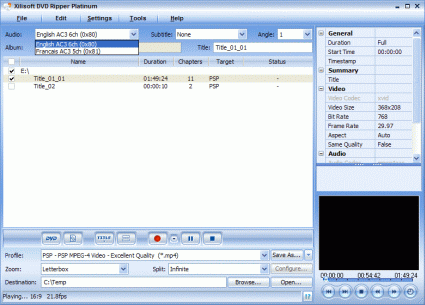All You Need To Know About Ripping DVDs
Sooner or later, you're going to need to rip a DVD. Mary Branscombe provides some tips for how to get the job done right and avoid getting scammed for ripping software.
Anatomy Of A DVD
You can put MPEG2 video onto a DVD disc, but it's not a DVD video if it doesn't have the right file structure. It won't have a menu, and many DVD players won't know what to do with it. If you put a DVD Video disc into your computer, you'll see at least two folders and a long list of files. Ignore the AUDIO_TS folder; it's the Audio Title Set and is used mainly for DVD Audio discs.
The VIDEO_TS folder is the one you're interested in since it contains Video Title Sets, the files that make up the movie and related content, plus the navigation information. If there are other folders at the top level of the DVD, they contain extra content like games, Web links and screensavers that you can use on your PC.

File structure of a Video DVD
There are three types of files in the VIDEO_TS folder: VOB (video object) files contain the video and audio information, IFO (information) files store the navigation and configuration files, and the BUP file is a backup for the IFO file. It is physically located on the outside tracks of the disc, so if the IFO file is scratched or obscured by dust, the BUP file will hopefully still work.
The files in the VIDEO_TS folder are organized into Video Title Sets. Each title set has one IFO file, one BUP file and at least two VOB files - one for the menu, and one for the video. A VOB file can't be larger than 1 GB, so if there's too much content you get more title sets with just the VOB files inside. There can be up to five of these in a row on a single-layer disc, or nine on a dual-layer disc, numbered by title and section.
One title set is the movie itself, while the others are the extra content: audio commentaries, slide shows, trailers and previews, cast and crew biographies, alternative endings and so on. There's also a title set made up of the VIDEO_TS.VOB, VIDEO_TS.IFO and VIDEO_TS.BUP files (it doesn't have a second VOB file). This is the content that plays automatically when you put the disc in your DVD player. Usually it's the copyright notice and FBI warning, but sometimes it's a menu that lets you watch trailers or set the language for the soundtrack. The VIDEO_TS.IFO file also contains the region coding for the disc.

Tools like DVD Decrypter can automatically select the right title sets for you.
Sign up to get the BEST of Tom’s Guide direct to your inbox.
Upgrade your life with a daily dose of the biggest tech news, lifestyle hacks and our curated analysis. Be the first to know about cutting-edge gadgets and the hottest deals.
The VOB files contain the video, audio and subtitle streams for the content in that title set - with all the different soundtracks, alternative camera angles or alternate language versions of images all multiplexed into a single file. The video is in MPEG2 format, at 720x480 resolution for NTSC discs and 720x576 resolution for PAL.
The audio is nearly always Dolby AC-3 format, although some early European and Japanese discs use uncompressed PCM audio (the same format as the WAV files on audio CDs). There may be two audio tracks, in stereo and 5.1 surround sound.

Most DVDs have soundtracks in multiple languages; picking just one saves space
The menu needs a VOB file of its own, because it can include video for the background or animated buttons. The IFO files are more than just the buttons on the menu; think of them as bookmarks, so your player knows where to begin that title set, and where to jump to when you choose a chapter or scene. They also contain the formatting information for the VOB files, including the aspect ratio, subtitles and soundtrack languages. If you rip a DVD without the IFO files, it may play incorrectly or not play at all.
Current page: Anatomy Of A DVD
Prev Page All You Need To Know About Ripping DVDs Next Page How To Rip a DVDMary Branscombe is an experienced freelance journalist, editor and author, who has been writing for more than three decades. Her work has appeared in The Financial Times, The Guardian, Tom's Guide, and many more. She has also written several novels — including the Cassidy At Large technomysteries — and two IT guides alongside her writing partner, Simon Bisson.
